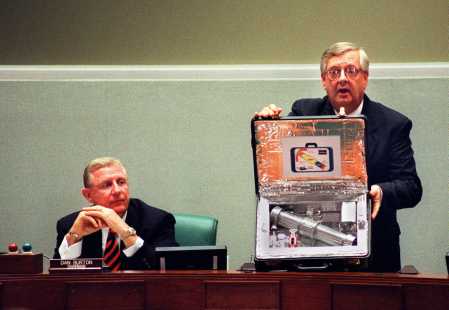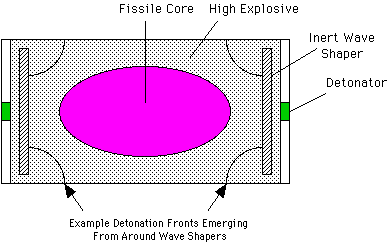You are correct, there is no such thing as a "suitcase nuke"!X-FID
Congressmen Dan Burton and Curt Weldon beg to disagree with you.


The smallest diameter US test device publicly known was the UCRL Swift device fired in the Redwing Yuma shot on 28 May 1956 . It had a 5" (12.7 cm) diameter, a length of 62.2 cm (24.5 inches) and weighed 43.5 kg (96 lb). The test had a yield of 190 tons, but was intended to be fusion boosted (and thus would probably have had a yield in the kiloton range) but its yield was insufficient to ignite the fusion reaction and it failed to boost in this test. This test may have been a predecessor to the W-48 design.
Later and lighter 155 mm designs were also developed -- the W74 (canceled early in development), and the W-82/XM-785 shell. The W82 had a yield of up to 2 kilotons and weighed 43 kg (95 lb), but included a number of sophisticated additional features within this weight. Since it was capable of being fielded with a "neutron bomb" (enhanced radiation) option, which is intrinsically more complex than a basic nuclear warhead, and was in addition rocket boosted, the actual minimum nuclear package was substantially lighter than the weight of the complete round. Its overall length was 86 cm (34").
It is reported that designs least as small as 105 mm (4.1 inches) are possible. A hypothetical 105 mm system developed for use in an artillery shell would be about 50 cm (20 inches) long and weigh around 20 kg.
Compact nuclear artillery shells (208 mm and under) are based on a design approach called linear implosion. The linear implosion concept is that an elongated (football shaped) lower density subcritical mass of material can be compressed and deformed into a critical higher density spherical configuration by embedding it in a cylinder of explosives which are initiated at each end. As the detonation progresses from each direction towards the middle, the fissile mass is squeezed into a supercritical shape. The Swift device is known to have been a linear implosion design.

It is quite likely, that should the suitcase bombs described by Lebed actually exist, that they would use this technology. It is clear that any of the 155 mm artillery shells, if shortened by omitting the non-essential conical ogive and fuze would fit diagonally in the package that Lebed describes, and the Swift device would fit easily. If the yield is as much as 10 kilotons, then the device would have to be fusion boosted.
A somewhat more sophisticated variation would extend the linear implosion concept to cylindrical implosion, in this case an oblate (squashed) spheroid, roughly discus-shaped, of plutonium would be embedded in a cylinder of high explosive which is initiated simultaneously around its perimeter. The cylindrically converging detonation would compress and deform the fissile mass into a sphere, that could be wider than the original thickness of the system. This type of design would make the flattest possible bomb design, perhaps as little as 5 cm. The only obvious application for such a device would be briefcase bomb, and would require a special development effort to create it.